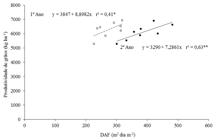ABSTRACT
The management of water and nitrogen are among the necessary actions to achieve high yield potential in irrigated agricultural systems. The objective of this study was to determine the influence of time of the beginning of flood and N topdressing, in the development stages from V3 - V4 until V12 - V13, on physiological characteristics positively related to grain yield of irrigated rice cultivar BRS Jaçanã in a tropical wetland. A field experiment was conducted at Palmital farm of Embrapa Rice and Beans, Goianira, GO, Brazil, in a Dystrophic Haplic Gleysol, for two consecutive years. The experimental design was completely randomized with six replications arranged in a split-plot scheme. The main plots were comprised by the times of the beginning of flood and subplots by the times of N topdressing of 90 kg ha-1. For both factors, the times were set as 15, 30, 45, and 60 days after emergence, which corresponded to the vegetative development stages V3 - V4, V6 - V7, V9 (VF-4) - V10 (VF-3), and V12 (VF-1) - V13 (VF). As flood delays, tillering, leaf area ratio, and specific leaf area increase and shoot biomass, leaf area index, and leaf area duration decrease. Late N fertilization timing also provides decrease in these physiological indices. Delay in flooding and N fertilization reduced more leaf area than rice grain yield, resulting in higher leaf area efficiency. Nitrogen topdressing performed at the beginning of tillering and continuous flooding at the middle tillering stage result in increased physiological indices, such as leaf area ratio, leaf area index, and leaf area duration, which provide increase in irrigated rice grain yield.
Key words:
Oryza sativa L.; growth; irrigation; management; nitrogen topdressing.

 Thumbnail
Thumbnail
 Thumbnail
Thumbnail
 Thumbnail
Thumbnail
 Thumbnail
Thumbnail
 Thumbnail
Thumbnail
 Thumbnail
Thumbnail
 Thumbnail
Thumbnail






